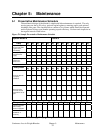Continuous Loss-in-Weight Blenders Chapter 4: Operation 48
The blender will blend at a maximum rate when the lower mass flow weigh hopper has a very
low weight of material. As the weight of material increases in the mass flow weigh hopper, the
controller will adjust the blender feeders output to match the calculated processing machine
rate. The blender will adjust in so that it is running a very closely matched rate to the extruder
and readjust the ingredient hopper outputs accordingly.
The processing rate and the blending rate displayed on the blender control will not match
exactly for any extended period of time as the dynamics of the extrusion process produces a
continuously changing rate for the extruder. The blender will follow this dynamic changing
rate very closely. The learned processing rate is accurate enough for mono-layer extrusion
yield control or co-extrusion layer thickness control.
If the extruder is slowed or stopped suddenly, the blender will reach the high weight point in
the lower mass flow hopper, slow down, and stop the metering devices so the weigh hopper
will not overfill.
Manual Backup Control System
Every continuous blender is equipped with a secondary manual backup control system. This
allows the blender to be switched over to manual operation. In this mode, the feeder speeds are
adjusted manually, and the blender will run, blending volumetrically. The lower mass flow
weigh hopper is equipped with a proximity sensor mounted on the upper level of the hopper.
This is for the manual operation to cycle the metering augers if the level of material in the
weigh hopper reaches a high level.
This secondary control will allow the blender to be operated to provide production in the event
of a control failure. After correction, the blender can be switched back into automatic
operation.
When the blender is running in steady automatic mode, simply check the motor voltages (or)
frequency readouts and record them. Then the drives can simply be “dialed in” for emergency
volumetric operation.


















